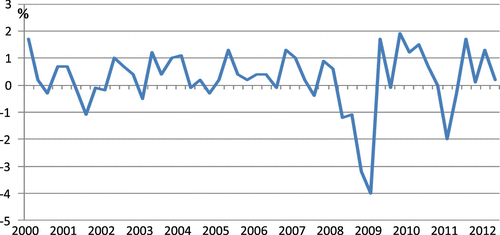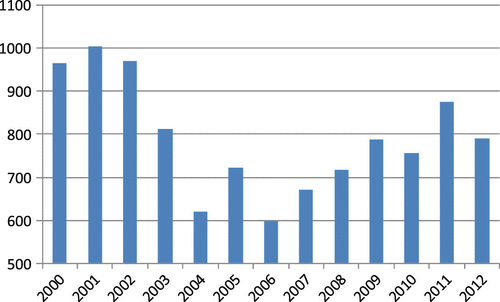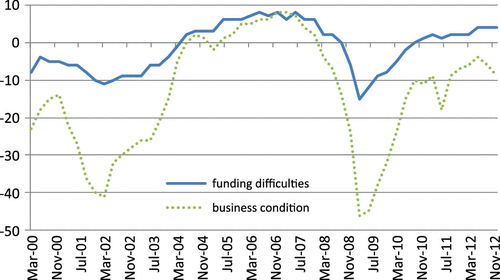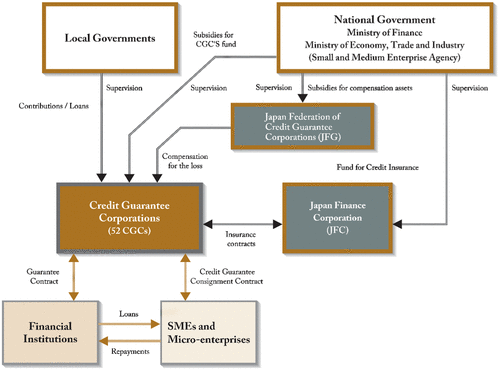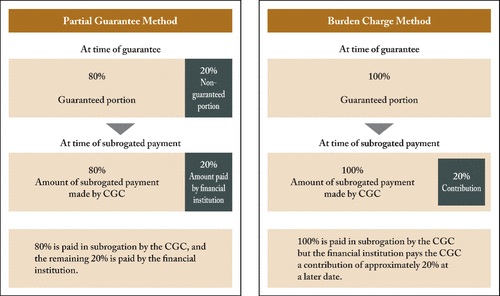Abstract
This paper provides a brief explanation of the Japanese public credit guarantee system and analyzes what role it played during the global financial crisis. The author conducted a questionnaire survey of small and medium-sized enterprises (SMEs) in Aichi Prefecture, the prefecture most seriously hit by the crisis, in collaboration with the Aichi-ken Credit Guarantee Corporation. Using the survey, which provides valuable information about the usage of the credit guarantee program, this paper finds that the credit guarantee system was effective in protecting the economy from collapsing. The system was so generous that now almost all SMEs want it to remain unchanged. However, as the generous system brings heavy financial burdens on the Japanese government and, more seriously, discourages firms and banks from improving their efficiencies, the author insists that reforms, such as limiting the target and the guarantee coverage, are inevitable.
Public Interest Statement
This paper provides a brief explanation of the Japanese public credit guarantee system and analyzes what role it played during the global financial crisis based on a questionnaire survey of Japanese small and medium-sized enterprises (SMEs) that the author conducted. Japan is known as the largest user of the public guarantee system in the world. This paper finds that the credit guarantee system was effective in protecting the economy from collapsing under the global financial crisis. The system was so generous that now almost all SMEs want it to remain unchanged. However, as the generous system brings heavy financial burdens on the Japanese government and, more seriously, discourages firms and banks from improving their efficiencies, the author insists that reforms, such as limiting the target and the guarantee coverage, are inevitable.
1. Introduction
After the collapse of the US’s Lehman Brothers in the fall of 2008, the global financial crisis began in the US and European countries. Initially, people expected that the negative impact on the Japanese economy would be marginal because Japanese financial institutions, on average, had smaller exposures to US subprime loan-related securities than did US and European banks, and mistrust of the soundness of the financial institutions did not intensify among the general public in Japan.
However, people soon recognized that the Japanese economy was being seriously hit. For example, the real economic growth rate of the fourth quarter of 2008 fell to −3.2%, and the growth rate of the first quarter of 2009 was −4.0%. In spite of this economic slump, it is notable that, unlike in the post-bubble financial crisis of the late 1990s, the economic difficulties were not attributable to the financial system, and it was commonly agreed that Japanese financial system did not encounter major problems.
The large decline due to the crisis in 2008 was not due to financial sectors but due to real economy sectors. That is, exports to Europe and the USA had dropped dramatically. As a result, the negative effect was particularly noticeable regarding Aichi, where our later-mentioned survey was conducted, because export-oriented industries such as automobiles and machinery industries are the backbone of the Aichi economy. Before the crisis, Aichi enjoyed rapid growth of exports and was regarded as the most vital region in Japan. Expecting further demand growth in the near future, not only large firms but also small and medium-sized enterprises (SMEs) had increased investment just before the crisis occurred. Naturally, the sudden drop in demand was not expected and, therefore, seriously affected the financing conditions of these firms.
Like other countries, the Japanese government employed various measures to deal with the crisis. As the Organization for Economic Co-operation and Development (OECD, Citation2013) shows, 19 out of 23 OECD member countries introduced or strengthened credit guarantee programs following the onset of the crisis. Japan was a typical example. At the end of October 2008, the Japanese government introduced the large-scale new guarantee program, called the Emergency Credit Guarantee Program (ECGP). This program is one of the largest single credit guarantee programs in the OECD countries, and Japan is the largest user of the credit guarantee system among the OECD countries, followed by Korea (see Figure ).
Figure 1. Credit guarantee schemes worldwide: volume of outstanding guarantees in portfolio, 2010.
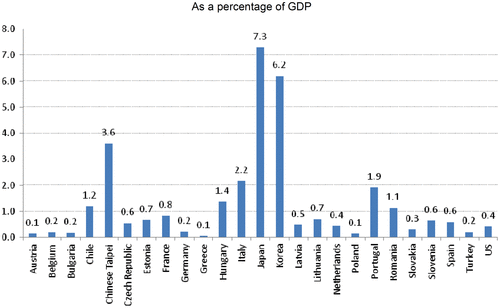
At a time when the Japanese economy was facing an economic crisis as a result of this unprecedented crisis, the author conducted a questionnaire survey of SMEs in Aichi Prefecture, which was the area most seriously hit by the crisis, in collaboration with the Aichi Credit Guarantee Corporation. The purpose of the survey was to explore whether the credit guarantee system effectively supported SMEs. In this paper, I will try to explain what roles the public guarantee system played in helping SMEs avoid financing difficulties during the crisis in Japan. For this purpose, I use the questionnaire survey just mentioned, because the Aichi economy is regarded as a typical example of the Japanese economy.
This paper consists of five sections. Following this introduction, I show the effects of the global financial crisis on the Japanese economy in Section 2. Section 3 overviews the Japanese credit guarantee system. Then, based on our survey results, I analyze how the credit guarantee system worked to tackle the crisis in Section 4. Section 5 concludes the paper.
2. Impact of the global financial crisis on Japanese SMEs
2.1. Sudden drop of real economic activity
The damage to the Japanese economy due to the global financial crisis was extraordinary. As shown in Figure , the real GDP growth rates were −3.2% for the fourth quarter of 2008 and −4.0% for the first quarter of 2009. The Japanese government and the Bank of Japan employed unprecedented measures to protect the Japanese economy from falling into “the greatest crisis of the century”.Footnote1 These measures included expansionary fiscal policy, zero-interest-rate monetary policy, loosening banking supervisory policy,Footnote2 and public capital injections to banks. One important measure was the establishment of a new public loan guarantee program, which is the main topic of this paper.
2.2. Number of bankruptcies
It is natural to expect that these sharp declines in economic activity would lead to a substantial increase in corporate bankruptcies. The number of corporate bankruptcies nationwide is shown in Figure . Although the number increased by 1,500 in 2008 from the previous year, it is considerably smaller than it was around 2001, when the figure reached over 19,000. A similar situation was found regarding Aichi Prefecture (see Figure ). Measured in corporate bankruptcies, the effect of the global financial crisis was not unprecedented.
A direct reason for this unexpected result is that firms could borrow new money and obtain various supports from financial institutions, including an exemption from the interest rate payment, a grace period for payment of the interest, a grace period for reimbursement of the principal, and a waiver of the claim. Therefore, in spite of the sharp deterioration in business conditions, funding difficulties for average firms only worsened moderately (see Figure ). As will be mentioned later, the public loan guarantee system significantly contributed to firms’ funding.
3. Brief sketch of the Japanese public credit guarantee system around the crisisFootnote3
3.1. Importance of the public credit guarantee system in Japanese SME finance
Figure is the overall picture of the Japanese credit guarantee system. When financial institutions intend to extend loans to SMEs, SMEs are often asked by banks to apply for credit guarantees from Credit Guarantee Corporations (CGCs). When the CGCs agree to offer guarantees to the firms, bank loans are executed. In addition to loan interest, firms pay guarantee fees to the CGCs through banks. When firms with these guarantees go into bankruptcy, lender banks ask the CGCs to compensate them for the losses. The Japanese government and local governments support the CGCs by providing subsidies and contributions directly and insurance through the Japan Finance Corporation (JFC).
The credit guarantee system is a system for small and medium-sized companies and small businesses. Therefore, borrowers must meet size and industry criteria to use the credit guarantee (see Table ). For example, the size criteria for manufacturing industries are either “300 million yen or less capital,” or “300 or fewer employees,” while those for retailers are either “50 million yen or less capital,” or “50 or fewer employees.”
Table 1. Eligible SMEs and micro-enterprises
Currently, the outstanding guaranteed liabilities of all CGCs amount to approximately 30 trillion yen. As shown in Figure , the liabilities grew rapidly in the 1990s from 16 trillion yen at the end of FY 1989 (i.e. March 1990) to 43 trillion yen at the end of FY 1999.
Figure 7. Outstanding guaranteed liabilities (trillion yen).
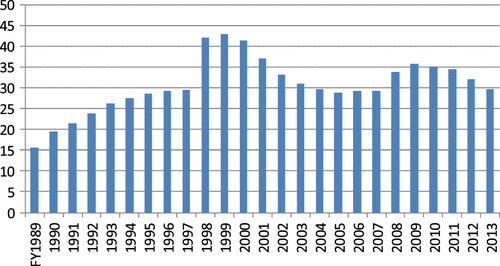
This remarkable growth was caused by a change in the Japanese government’s SME support policies. Public financial institutions such as National Life Finance Corporation, which lend money directly to SMEs, used to be a major policy tool. However, public finance reform was advanced, based on the idea of leaving what private firms can do to them rather than to public institutions. Therefore, it was regarded as a good thing to decrease direct financing by public financial institutions; the public guarantee scheme seemed consistent with this idea, because it supports private banks when they cannot take the credit risks associated with financing SMEs by themselves. When Japan suffered from the financial system crisis in the late 1990s, the government established the Special Guarantee Program in 1998. The Special Guarantee Program contributed to the large increase of outstanding liabilities in 1998.
According to the Japan Federation of Credit Guarantee Corporations, the utilization ratio of guarantees is far higher than that of direct loans provided by JFC, which was established with the merger of National Life Finance Corporation and Small Business Finance Corporation and started operation in 2008, and Shoko Chukin Bank (see Table ). As of the end of March 2013, 1.5 million SMEs, or 35.8% of all SMEs in Japan, had received credit guarantees.
Table 2. Number of users (in thousands)
3.2. Credit guarantee system reform before the crisis
The historical development of the credit guarantee system in Japan is summarized in Table . It had a landmark event in 2005, when the Japanese government decided to reform the credit guarantee system. The old system had two distinct characters, such as risk-unrelated fixed guarantee fees and a 100% guarantee.Footnote4
Table 3. Historical development of the Japanese credit guarantee system
3.2.1. Risk-related guarantee-fee scheme
In 2006, a risk-related guarantee-fee scheme was introduced. Under the previous risk-unrelated fixed-fee scheme, riskier borrowers enjoyed effectively cheap guarantees and good borrowers hesitated to use expensive guarantees. Under the new scheme, rates for fees were determined based on the financial position of the borrowers. There are nine different guarantee fee rates from 0.45 to 1.90% (expressed as an annual percentage of the value of the loan) for the responsibility-sharing system and from 0.50 to 2.20% for the non-responsibility-sharing system, as shown in Table .
Table 4. Credit guarantee fee rate classification
There are still strong critics who contend that the fee rates do not sufficiently reflect the risk differences; they maintain that riskier borrowers should pay higher fees based on their real credit risks. However, the government successfully overcame political difficulties created by the introduction of the new fee scheme due to the fact that many small firms disliked it. This qualitative change of the government policy should be evaluated as a first step toward the desired destination.
3.2.2. Responsibility-sharing system
In 2007, the so-called responsibility-sharing system was introduced. Before that, financial institutions had no losses even when guaranteed borrowers failed to pay back; all losses were absorbed by the CGCs. Naturally, financial institutions did not have enough incentives to screen for good borrowers, monitor the borrowers carefully, and support troubled borrowers to revitalize their business plans. Under the new system, financial institutions share some part of the loss when borrowers default.
Technically speaking, the responsibility-sharing system comprises two methods, the partial guarantee method and the burden charge method, as depicted in Figure . For example, under the partial guarantee method, the CGC guarantees 80% of each loan. This means that 20% of losses are borne by the lender banks.
3.3. The Emergency Credit Guarantee program
In response to the financial crisis, the Japanese government introduced various measures in order to alleviate the massive adverse shocks to the economy. Among these measures, the Japanese government introduced the ECGP in 2008. This program is one of the largest single credit guarantee programs in the OECD countries, with planned guarantees amounting to 36 trillion yen and actual guarantees amounting to 27 trillion yen.Footnote5 Owing to this new program, approval amounts of new loan guarantees jumped in FY 2008 and 2009 (see Figure ).
Figure 9. Approval amounts of new loan guarantees (trillion yen).
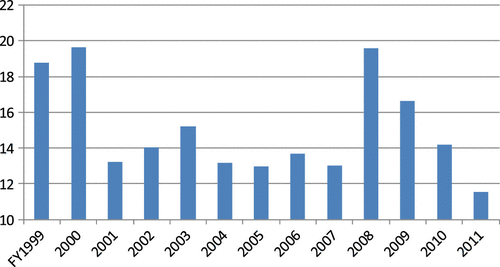
As compared to the Standard Credit Guarantee Program (SCGP), the ECGP has the following institutional features. First, CGCs assume all risks (i.e. 100% guarantees); thus, banks that extend ECG loans bear no credit risks. Second, the maximum duration of an ECG loan is 10 years, whereas that of a standard credit guaranteed loan is seven years. Third, in contrast with the standard program, where the premium varies from 0.45 to 1.9%, the premium for ECG loans is a fixed percentage (0.75–0.80%) not dependent upon the creditworthiness of the borrowers. To reduce the payment burden for risky borrowers, ECG guarantee premiums are lower than the average premium charged to standard program users. Therefore, good borrowers tend to use the standard program, while risky borrowers tend to use the ECGP. Finally, while the risk weight of standard credit guaranteed loans under the Basel II Capital Accord is 10%, the risk weight of the ECG loans is set to 0% in order to facilitate the use of the ECGP by banks.
4. SME survey in Aichi Prefecture just after the crisis
4.1. Sample firms
We set the following conditions for choosing sample firms. First, we included firms that borrowed money using credit guarantees provided by the Aichi Credit Guarantee Corporation from January 2009 to July 2009.Footnote6 Second, we included only corporations located in Aichi Prefecture. Third, we included firms that reported their financial statement for the fiscal-year ending from January 2009 to July 2009. There were 12,070 firms that satisfied these conditions.
We sent a questionnaire to these 12,070 firms on 14 September 2009. By October 27, we had received 4,885 responses, resulting in response rate of 40.2%.
Before reporting the survey results, we will provide an overview of our sample firms. First, let us look at the number of employees. As shown in Table , 33.0% of the companies employ five or less employees, 25.9% employ 6–10 people, 20.1% employ 11–20 people, 14.1% employ 21–50 people, and only 7.1% employ 51 or more employees. Small companies dominated in our sample, compared to other survey studies.
Table 5. Size of respondents
Second, to see how seriously the sample firms were hit by the crisis, we focused on the change in sales from the previous year. The results are shown in Table . 69.9% of respondents suffered decreased sales, while only 16.3% increased their sales.
Table 6. Changes in sales from the previous year
As business conditions of firms deteriorated significantly after the crisis occurred, it was natural for banks to re-evaluate the creditworthiness of customers and downgrade their credit ratings. Therefore, we expected our sample firms to face financial difficulties. We asked firms whether their main banks demanded to change several loan conditions, such as interest rate, amount borrowed, and collateral. The results are summarized in Table .
Table 7. Changes in borrowing conditions
As the crisis increased the riskiness of borrowers, we expected borrowing conditions to become more severe. Unexpectedly, as shown in table, borrowing conditions generally changed favorably for borrowers. For example, 28.6% of respondents said they could borrow more money, and 22.0% of them could borrow money with longer maturities. Furthermore, 11.2% of firms said that their borrowing interest rates decreased. As will be explained later, these unexpected results were mainly caused by the credit guarantee programs.
4.2. Usage history of credit guaranteed loans
We asked, “How long do you use the credit guarantee?” The result is summarized in Table . Approximately, 70.0% of respondents have used the guarantees for 10 years or longer. Only 10% of them chose 2 years or shorter, meaning that a minority of current users likely obtained the guarantees to deal with difficulties temporarily brought by the crisis. In other words, 90.0% of respondents used the guarantees regardless of the occurrence of the global financial crisis. Many firms rely chronically upon the credit guarantee system.
Table 8. Usage history of credit guarantees
4.3. Type of credit guarantee programs that are used
As the ECGP was established in 2008, firms could choose either the ECGP or the SCGP. Note that all of our sample firms actually borrowed guaranteed loans after the ECGP started. We asked firms about types of guarantee programs that they used. The result is shown in Table .
Table 9. Types of credit guarantee programs used
Firms that used both the ECGP and the SCGP accounted for approximately half of the sample. In addition, 20.6% of respondents used only the ECGP. Therefore, approximately 70.0% of firms used the ECGP. This demonstrates that the ECGP played a significant role in firms’ dealing with the crisis. However, it is notable that 19.0% of respondents still used only the SCGP. This is because the fees for the SCGP are cheaper than those for the ECGP for creditworthy firms. As shown in Table , fee rates for firms in classifications 8 and 9 are 0.60 and 0.45%, respectively, which are far lower than the fixed rates for the ECGP (i.e. 0.75–0.80%). In summary, the ECGP helped relatively weak firms to get funds with cheaper costs.
4.4. Ratio of guaranteed borrowing to total borrowing
We asked the ratio of the money borrowed with credit guarantees to the total amount borrowed from financial institutions. As shown in Table , companies that answered “80% or more” accounted for approximately half of the sample (45.4%). In particular, smaller enterprises were more likely to have a higher guaranteed coverage ratio. For example, more than 60% of firms with 5 or less employees had “80% or more” guaranteed coverage. Small businesses tend to be heavily dependent on credit guarantees.
Table 10. Ratio of guaranteed borrowing
4.5. How to deal with the crisis
Table shows how SMEs tackled the crisis. Some firms controlled spending that was not urgent, including the postponement of capital investment, and decreased expenditures by laying off employees. However, the table shows that the most important measure was the use of guaranteed loans. Namely, most of the respondents (72.3%) chose “Expansion of credit guaranteed loans from financial institutions,” which was far ahead of other measures. We can confirm that the credit guarantee system played a crucial role for the survival of SMEs in the crisis. It is notable that 6.9% of the respondents considered going out of business.
Table 11. Measures taken to tackle the crisis
4.6. Who advised firms to use recent guaranteed loans?
As Table shows, 63.5% of respondents were advised to use guaranteed loans by their main banks or other banks. This result suggests that it was the banks that needed the guaranteed loans. Banks found that the creditworthiness of their customers suddenly deteriorated, and they decided not to lend more to customers without the public credit guarantees.
Table 12. Who advised firms to use guaranteed loans?
According to the relationship banking business model, banks are expected to support customers with long-term relationships when the customers suffer from temporal difficulties. However, this model does not work well under macroeconomic shocks, because all customers face difficulties at the same time. As banks cannot diversify risks, risks that banks are forced to take in order to support customers will exceed the ability of the banks. This actually happened during the crisis. In summary, the Japanese bank loan markets could not have functioned well without public support.
4.7. Necessity of the guaranteed loans
We asked firms what they would have done if their application for guaranteed loans had been refused. Note that all respondents successfully borrowed money with public guarantees after the global financial crisis occurred. Therefore, this is a hypothetical question.
Table shows the results regarding this question. Only 16.3% of respondents said “There was no trouble, especially.” That means that the remaining 83.7% of firms would have faced some troubles, if their applications for guaranteed loans had been rejected. Approximately, 60.0% of respondents chose “applying for loans without guarantees,” either to financial institutions whose loans the CGC refused to guarantee (39.7%) or to other financial institutions (19.3%). In addition, “I would review the filings with the CGC and, once again, carry out an application for credit guarantee” and “I would apply for loans to government-affiliated financial institutions” also have relatively high selection ratios. The fact that the number of firms that chose these four choices was very high confirms that there was a strong need for funds during the crisis.
Table 13. What would the firms have done if their application for guaranteed loans had been rejected? (Multiple choices)
Furthermore, it is notable that the rate of potentially going out of business was high. More than 10% of firms chose “I would give up continuation of the business.” Considering the firms that used the ECGP, the ratio further rises to 12.0%. Comparing the ratio of 7.3% for the SCGP, the ECGP had the larger effect for keeping firms doing business because weaker firms could get guaranteed with cheaper fees under the ECGP.
Assuming that the potential rate of going out of business was 10.5%, the Aichi-ken Credit Guarantee Corporation (ACGC), which approved 57,689 applications from November 2008 to July 2009, prevented approximately 6,000 firms from going out of business. In other words, as the average number of employees at our sample firms was 15.1, the ACGC secured jobs for 88,000 people. At the time, there were 209,000 unemployed people in Aichi Prefecture. If the ACGC had not provided the guarantees, the number of unemployed would be 1.5 times higher than the actual figures.
4.8. Future usage of credit guarantees
As the results above demonstrate, the credit guarantees supported SMEs effectively during the financial crisis. It is also interesting to know whether firms plan to use it during a normal period. Furthermore, if SMEs say that they want to use the credit guarantees in the future, it is important to understand the reasons why they would do so.
The responses are summarized in Table . Only 2.0% of respondents answered, “I do not want to use it.” Almost half of respondents (47.4%) chose “I want to use it because I can borrow without collateral.” Assuming that the first three choices, i.e. “I want to use it because I can borrow at a fixed interest rate,” “I want to use it because I can borrow without collateral,” and “I want to use it because there are positive reasons other than those mentioned above,” are classified as positive reasons, most firms will positively use the credit guarantees. Therefore, the results suggest that many SMEs expect that the public credit guarantee system will continue to play an important role for them to get funds in the future.
Table 14. Whether firms will use the credit guarantees and why they do so
4.9. SMEs’ general opinions on the reform of the credit guarantee system
As explained in Section 3, the Japanese government started reforming the credit guarantee system in the middle of the 2000s, while the global financial crisis forced the government to introduce the ECGP, which was inconsistent with the reform. Fortunately, the ECGP and other various measures that the government took prevented the crisis from destroying the economy. Judging that the economy had returned to normal, the government decided to let the ECGP expire in March 2011. Now, as the economic circumstances are stable, it is an appropriate time to reconsider the future of the credit guarantee system.
We asked firms how they felt about the five statements listed in Table . Almost all firms agree with the statement, “The credit guarantee system is important for the support of small and medium-sized enterprises.” Also, the fifth statement, “The guaranteed amount should be expanded” also has gained a lot of supports from SMEs. Therefore, many SMEs expect the credit guarantee system to continue to play an important role in supporting SMEs in Japan.Footnote7
Table 15. Opinions on the future of the credit guarantee system
The second through fourth statements are related to the targets that the credit guarantee system should support. I think that the credit guarantee system should make clear whom they want to support, and that reasonable targets should be firms that have high potential for growth and firms that suffer from temporary negative shocks. However, the majority of SMEs disagree with these statements. Also, most firms dislike the idea that the credit guarantee system should support only small firms; thus, they reveal their preference for supporting wider coverage of guarantees.
Currently, the sustainability of the current public guarantee system is questioned and it is commonly expected that the constraints due to the government’s financial resources will become strict, resulting in a significant reduction of the coverage of the credit guarantee programs.
Although detailed information is limited, Okada (Citation2013) tried to consolidate the financial statements of all 52 CGCs (see Table ). The net balances of the CGCs were in the black and, at first glance, seemed financially sound. By scrutinizing Table , however, we recognize a different fact. The CGCs paid 146 billion yen to the JFC as credit insurance premiums, while they received 660 billion yen from the JFC as insurance proceeds. CGCs received insurance proceeds that were 4.5 times larger than the insurance premiums they paid. The difference between the insurance premiums and insurance proceeds, in addition to subsidiaries and loss compensations provided by both national and local governments (approximately 83 billion yen, according to Table ), keeps the CGCs afloat. In turn, the JFC shoulders the burdens caused by the insurance deficits. Actually, as shown in Table , the JFC’s deficits in the insurance business amounted to 567.9 billion yen for FY 2009 and have remained very large since then. These deficits are made up for by compensations and contributions from the government. Therefore, whether the current guarantee system can remain unchanged fundamentally depends on whether the government can continue to provide such huge financial supports to the JFC.
Table 16. Revenue and expenditure of 52 Credit Guarantee Corporations (FY 2011) (million yens)
Table 17. JFC’s credit insurance business (billion yens)
Long-term debt outstanding of local and central governments amounts to 1,010 trillion yen, or two times larger than Japan’s Gross Domestic Product at the end of FY 2014. Unfortunately, the ratio is extremely high among major nations, and the Japanese government is known for its fragile financial positions (see Figure ). Therefore, the Japanese government, with its high dependency on borrowing, has officially announced its intention to achieve a surplus in the primary balance.Footnote8 Therefore, it is difficult for the government to continue contributing such huge burdens to the credit guarantees. Once again, I maintain that we must specify who are the main targets that the credit guarantee system intends to help. Unfortunately, as the credit guarantee system worked very successfully during the crisis and many SMEs actually enjoyed the benefits from the generous guarantees, I admit that reform will be hard, as some SMEs will lose the vested benefits. We must make an effort to reach consensus regarding the main targets.
Figure 10. General government net debt (international comparison).
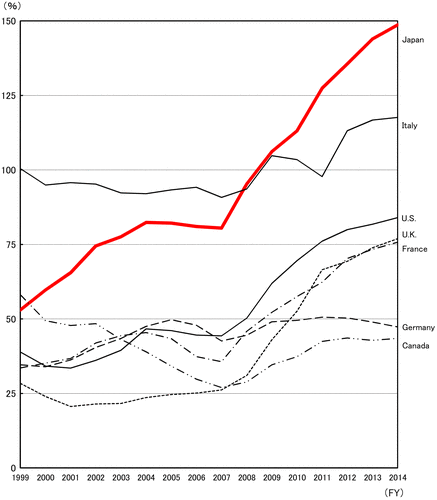
5. Concluding remarks
In this paper, using the results of a questionnaire survey conducted in September 2009 among companies that borrowed guaranteed loans from financial institutions in Aichi Prefecture after the global financial crisis occurred, we analyzed how the Japanese credit guarantee system functioned to contain the negative impact of the global financial crisis.
This study shows the following. The performance of SMEs in Aichi Prefecture deteriorated rapidly during the crisis, and many companies were forced to borrow necessary working capital. As the creditworthiness of these firms worsened and banks likely hesitated to extend loans, firms were expected to face serious financial difficulties. However, the reality was not what was expected. Many companies could increase their borrowing with favorable conditions, including lower interest rates and longer periods for repayment. Why could Japanese banks offer such supportive loans during the crisis? Did they take risks recklessly or philanthropically? The answer is, of course, No. The banks actually did not take risks, but transferred risks to CGCs. In turn, the CGCss were supported by the favorable credit insurance provided by the government-owned Japan Financial Corporation. In summary, it was the government that took risks by utilizing and expanding the public credit guarantee system. Particularly, the ECGP that was launched in October 2008 was a very effective measure. Under the ECGP’s offering guarantees with fees not related to borrowers’ riskiness, weak firms received guaranteed loans with favorable guarantee fee rates.
These results demonstrate that the credit guarantee system effectively protected the economy, and many SMEs enjoyed the benefits of the credit guarantee system. Therefore, most SMEs support not the reduction of the credit guarantee system but further enhancement of it. However, the ECGP was inconsistent with the reform policy that the government had pursued before the crisis in two respects: the ECGP offered 100% guarantees to banks, and it charged firms fixed fee rates that were not dependent on the riskiness of the firms.
Our study shows that the ECGP and other guarantee programs have been so successful that most SMEs demand that the current system remain unchanged. It seems likely that banks also will have no incentive to push the current system to change. Generous guarantees likely helped firms that had fundamental difficulties but did not conduct serious restructurings, so-called “Zombie” firms, to remain alive. The existence of Zombies decreases the efficiency of the economy.
The government was forced to postpone the reform during the crisis, but now the credit guarantee system should change in accordance with the economic situation. As the economy has now recovered from the crisis, it is a good time to restart the reform. Many observers admit that the current credit guarantee system is kept afloat by huge subsidies and contributions from the central and local governments, but the fragile financial positions of the governments suggest these supports surely are not sustainable. The Japanese government must hurry to rebuild a credit guarantee system that makes clear whom it should support, and encourages firms and banks to make an effort to increase efficiency and competiveness.
Acknowledgements
This paper is part of the results of a joint study receiving a Grant-in-Aid for Scientific Research from the Japan Society for the Promotion of Science. The author expresses his thanks to participants for giving various comments at the international conference held by the Daejeon and Chungnam Branch, Bank of Korea, on June 9, 2014.
Additional information
Funding
Notes on contributors
Nobuyoshi Yamori
Nobuyoshi Yamori was born in Shiga Prefecture in Japan and graduated from Shiga University in 1986. He received an MA degree at Kobe University in 1988 and PhD at Nagoya University in 1996. Before becoming a professor of Kobe University in 2014, he taught at Nagoya University. He was also appointed as a visiting scholar at Columbia University, Federal Reserve Bank of San Francisco, and University of Auckland (New Zealand). He has published many academic articles in international journals, such as Economics Letters, Journal of Banking and Finance, Journal of Financial Intermediation, Journal of Financial Research, Journal of Financial Services Research, Journal of International Financial Markets, Institutions, and Money, and Journal of Risk and Insurance.
Notes
1. See Yamori, Kondo, Tomimura, Shindo, and Takaku (Citation2013) for more details about various policies that the Japanese government took.
2. For example, the definition of non-performing loans was revised. Now, many loans to dubious borrowers were classified as performing loans if they could develop a reliable recovery plan.
3. The explanation in this chapter relies on Japan Federation of Credit Guarantee Corporations, credit guarantee system in Japan 2013.
4. Another important reform was the introduction of the principal of not requiring third-party guarantees.
5. The program expired in March 2011. Ono, Uesugi, and Yasuda (Citation2011) analyze the ECGP, while Uesugi, Sakai, and Yamashiro (Citation2010) examine the effects of the SGP.
6. Aichi-ken is the most industrial region in Japan. For example, Toyota Motor Corporation has its head office in Aichi.
7. As our sample firms are users of the credit guarantee loans, it seems natural that the support for the credit guarantee is high.
8. “Large-boned Policy” or Honebuto-no-Houshin, decided and released by the Abe cabinet on June 14, 2013, mentions that the primary balance of the central and local governments should be recovered by FY 2020.
References
- Okada, S. (2013). Current status and issues surrounding the credit guarantee system. National Diet Library, Issue Brief 794 (in Japanese).
- Ono, A., Uesugi, I., & Yasuda, Y. (2011). Are lending relationships beneficial or harmful for public credit guarantees? Evidence from Japan’s emergency credit guarantee program ( RIETI Discussion Paper Series 11-E-035). Tokyo: Research Institute of Economy, Trade and Industry (RIETI).
- Organization for Economic Co-operation and Development. (2013). SME and entrepreneurship financing: The role of credit guarantee schemes and mutual guarantee societies in supporting finance for small and medium-sized enterprises (Final Report). Paris: Centre for Entrepreneurship, SMEs and Local Development.
- Uesugi, I., Sakai, K., & Yamashiro, G. M. (2010). The effectiveness of public credit guarantees in the Japanese loan market. Journal of the Japanese and International Economies, 24, 457–480.https://doi.org/10.1016/j.jjie.2010.08.001
- Yamori, N., Kondo, K., Tomimura, K., Shindo, Y., & Takaku, K. (2013). Japanese banking regulations and SME finance under the global financial crisis. Japanese Journal of Monetary and Financial Economics, 1, 59–90.

